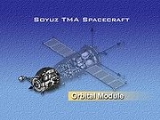
Orbital module
Encyclopedia
The orbital module is a portion of spacecraft used only in orbit. These have developed from the Soviet Soyuz spacecraft.
 The orbit module is a spherical part of Soviet-Russia
The orbit module is a spherical part of Soviet-Russia
n Soyuz
space ship series. Designed for use only in orbit, the module does not need to be strengthened to survive re-entry, allowing it to provide more usable space for less weight than other manned capsule designs.
It serves mainly for rest and hygiene procedures of a ship's crew during phase of orbital flight when used as a space station ferry, though on early Soyuz missions the module was used for experiments and even as an airlock for the Soyuz 4
/Soyuz 5
EVA crew transfer.
, the orbital module has been upgraded to carry its own solar panel
s and orbital maneuver
system, so it is capable of operating independently as a free-flying spacecraft after separating from the reentry module and the service module
.
(Crew Space Transportation System) also follows the three module layout of the Soyuz
and will include an orbital module.
Soyuz orbit module

Russia
Russia or , officially known as both Russia and the Russian Federation , is a country in northern Eurasia. It is a federal semi-presidential republic, comprising 83 federal subjects...
n Soyuz
Soyuz spacecraft
Soyuz , Union) is a series of spacecraft initially designed for the Soviet space programme by the Korolyov Design Bureau in the 1960s, and still in service today...
space ship series. Designed for use only in orbit, the module does not need to be strengthened to survive re-entry, allowing it to provide more usable space for less weight than other manned capsule designs.
It serves mainly for rest and hygiene procedures of a ship's crew during phase of orbital flight when used as a space station ferry, though on early Soyuz missions the module was used for experiments and even as an airlock for the Soyuz 4
Soyuz 4
Soyuz 4 was launched on January 14, 1969. On board the Soyuz 7K-OK spacecraft was cosmonaut Vladimir Shatalov on his first flight. The aim of the mission was to dock with Soyuz 5, transfer two crew members from that spacecraft, and return to Earth...
/Soyuz 5
Soyuz 5
Soyuz 5 was a Soyuz mission using the Soyuz 7K-OK spacecraft launched by the Soviet Union on January 15, 1969, which docked with Soyuz 4 in orbit...
EVA crew transfer.
Shenzhou orbit module
In the Chinese Shenzhou spacecraftShenzhou spacecraft
Shenzhou is a spacecraft developed and operated by the People's Republic of China to support its manned spaceflight program. The name is variously translated as "Divine Craft," "Divine Vessel of God," "Magic Boat" or similar and is also homophonous with an ancient name for China...
, the orbital module has been upgraded to carry its own solar panel
Photovoltaic module
A solar panel is a packaged, connected assembly of solar cells, also known as photovoltaic cells...
s and orbital maneuver
Orbital maneuver
In spaceflight, an orbital maneuver is the use of propulsion systems to change the orbit of a spacecraft.For spacecraft far from Earth—for example those in orbits around the Sun—an orbital maneuver is called a deep-space maneuver .-delta-v:...
system, so it is capable of operating independently as a free-flying spacecraft after separating from the reentry module and the service module
Service module
A service module is a spacecraft compartment containing a variety of support systems used for spacecraft operations. Usually located in the uninhabited area of the spacecraft, the service module is jettisoned upon the completion of the mission, and usually burns up during atmospheric reentry...
.
Other orbit modules
The present form of the planned Euro-Russian CSTSCSTS
CSTS or ACTS is a human spaceflight system proposal. It was originally a joint project between the European Space Agency and the Russian Space Agency , but is now solely an ESA project...
(Crew Space Transportation System) also follows the three module layout of the Soyuz
Soyuz spacecraft
Soyuz , Union) is a series of spacecraft initially designed for the Soviet space programme by the Korolyov Design Bureau in the 1960s, and still in service today...
and will include an orbital module.
See also
- Reentry module
- Service moduleService moduleA service module is a spacecraft compartment containing a variety of support systems used for spacecraft operations. Usually located in the uninhabited area of the spacecraft, the service module is jettisoned upon the completion of the mission, and usually burns up during atmospheric reentry...
- Command module
- Space capsuleSpace capsuleA space capsule is an often manned spacecraft which has a simple shape for the main section, without any wings or other features to create lift during atmospheric reentry....

